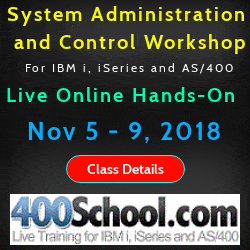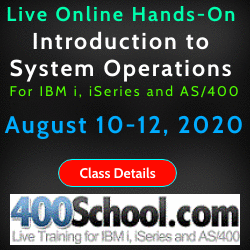
|
||
|
SecureMyi.com Security and Systems Management Newsletter for the IBM i
February 12, 2014 - Vol 4, Issue 2
|
||

|
||



|
Feature Article
|
|
In This Issue
Quick Links
Our Newsletter Sponsors
Platinum Sponsor |
IBM i Security ResourcesIBM i Security Videos - SecureMyi RedBook - Security Guide IBM i 


|


|

|
||

|



|
|

|
||
Security Shorts -
By Dan Riehl IBM has provided the MI built-in function MODINVAU to modify the Adopted Authority attributes of a program's invocation level. In effect, it allows you to control the propagation of Adopted Authority from within a program. The MODINVAU function has one argument that can contain one of two values:
If '00' is specified, normal propagation of adopted authority to called programs and subprograms occurs. If '01' is specified, adopted authority is not propagated to called programs and subprograms. Here's an example of using the function in a Control Language program.
Pgm
CallPrc Prc( '_MODINVAU' ) Parm(x'01')
/* Suppress Adopted Authority */
Go Main
EndPgm
This simple program uses the MODINVAU function to flip the invocation authority switch so that any adopted authority is not propagated to subsequent programs. In this case, the program takes us to the menu name MAIN, and adopted authority is not in effect at the MAIN menu. When we exit from the MAIN menu by using F3, we return to the calling program, where any adopted authority is still in effect. I suggest using this MI function in your application development to achieve more granular control over adopted authority. If a program needs adopted authority, create the program to adopt. But then also use the MODINVAU function to block the adopted authority from traveling down the stack to other programs. It's a much more elegant design than trying to take control of all your programs by using the USEADPAUT(Use Adopted Authority) program attribute. If your adopting programs don't pass on their adopted authority, many security issues can be alleviated. You can read more about MODINVAU in the IBM Information Center article on MODINVAU. For additional information about Controlling Adopted Authority Check out this detailed IBM article. |
Sponsored Links
IBM i, iSeries and AS/400
|
|

|
||

|
||
|
Send your IBM i Security and Systems Management News and Events! Send your Questions, Comments, Tips and Stories Copyright 2014 - SecureMyi.com, all rights reserved SecureMyi.com | St Louis MO 63017 |
||